-
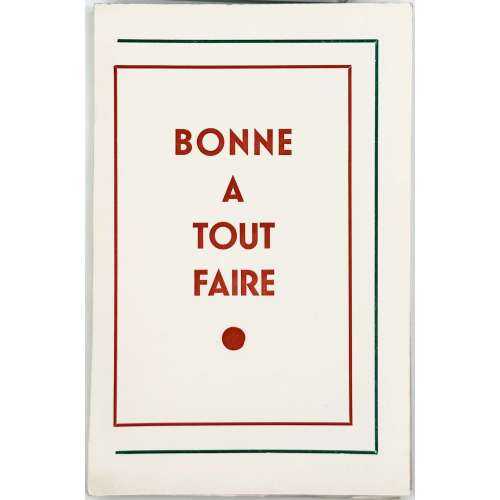 A softcover volume 18.7 x 12.1 cm, in publisher’s cream wrappers, red lettering in red and green frames to front cover, in glassine dustwrapper, uncut, untrimmed, collated in 8vo: 1-98 104, pp. [1-8] 9-151 [152 blank], plus 6 illustrations reproduced in drypoint after Mario Tauzin's lithographs from the album 'Interdit aux adultes' (see SVE-0547.2024). Front cover : BONNE | A | TOUT | FAIRE Title-page : BONNE | A | TOUT | FAIRE Stated limited edition of 900, strictly for subscribers. According to J.-P. Dutel III 1108 (p.66): published by Éric Losfeld in the late 1950s. Bonne à tout faire is a French idiom = maid-of-all-work Éric Losfeld (Belgian-French, 1922 – 1979) — publisher Mario Tauzin (French, 1909 – 1979) — artist
A softcover volume 18.7 x 12.1 cm, in publisher’s cream wrappers, red lettering in red and green frames to front cover, in glassine dustwrapper, uncut, untrimmed, collated in 8vo: 1-98 104, pp. [1-8] 9-151 [152 blank], plus 6 illustrations reproduced in drypoint after Mario Tauzin's lithographs from the album 'Interdit aux adultes' (see SVE-0547.2024). Front cover : BONNE | A | TOUT | FAIRE Title-page : BONNE | A | TOUT | FAIRE Stated limited edition of 900, strictly for subscribers. According to J.-P. Dutel III 1108 (p.66): published by Éric Losfeld in the late 1950s. Bonne à tout faire is a French idiom = maid-of-all-work Éric Losfeld (Belgian-French, 1922 – 1979) — publisher Mario Tauzin (French, 1909 – 1979) — artist -
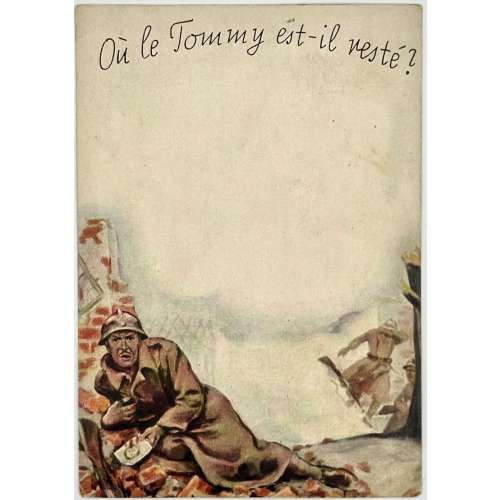 One of a series of six anti-allies propaganda cards, printed in colour, inscribed Ou le Tommy est-il resté? (Where did Tommy stay?), where Tommy is slang for a common soldier in the British Army. The postcards visibly depict French soldiers who fight and die at the western front, while the covert watermark image shows a British military having fun in a bordello. Those cards were printed in the Third Reich for France and dropped from aeroplanes to motivate French soldiers to fight against the British. Size: 149 x 104 mm
One of a series of six anti-allies propaganda cards, printed in colour, inscribed Ou le Tommy est-il resté? (Where did Tommy stay?), where Tommy is slang for a common soldier in the British Army. The postcards visibly depict French soldiers who fight and die at the western front, while the covert watermark image shows a British military having fun in a bordello. Those cards were printed in the Third Reich for France and dropped from aeroplanes to motivate French soldiers to fight against the British. Size: 149 x 104 mm -
 Hardcover, light grey cloth with brown lettering and two-colour vignette in the central panel, lettering to spine, 15 woodcut headpieces to each book and 5 full-page two-colour woodcuts by Leonid Feinberg (1896-1980). Size: 25.5 x 18.5 cm; collation: 8vo. Frontispiece (grey and black): P. OVIDII NASONIS | METAMORPHOSEON | LIBRI | {XV in frame} | ACADEMIA || Title-page (grey and black): П. ОВИДИЙ HAЗOH | МЕТАМОРФОЗЫ | ПЕРЕВОД | С. В. ШЕРВИНСКОГО | СТАТЬЯ О ТВОРЧЕСТВЕ ОВИДИЯ | А. И. БЕЛЕЦКОГО | РЕДАКЦИЯ И КОММЕНТАРИИ | Ф. А. ПЕТРОВСКОГО | {vignette / 1937} | ACADEMIA || Imprint: Переплет, иллюстрации, заставки | и титульные страницы по рисункам | Л. Е. Фейнберга || Published: II-1937; print-run: 5,300 copies. Pp.: [i-vi] vii-xxix [xxx] [2] 3-358 [8], total 396 pp: i/ii publisher’s device/blank, iii/iv blank/frontis., v/vi t.p./imprint, vii-xxx text preface, 1/2 h.t./blank, 3-330 text,331/2 h.t./blank, 333/59 commentary, 360 summary, 361/2 table of contents/blank, 363/4 errata/blank, 365/6 colophon/blank. Collation: ffl, i8 ii7 1-228 237, ffl, total 198 leaves plus 5 full-page two-colour woodcuts extraneous to collation. Publius Ovidius Naso [Ovid] (Roman, 43 BC – AD 17/18) – Author. Белецкий, Александр Иванович (Ukrainian, 1884 – 1961) – Author (foreword) Петровский, Фёдор Александрович (Russian,1890 – 1978) – Author (editor) Шервинский, Сергей Васильевич (Russian, 1892 – 1991) – Translator Фейнберг, Леонид Евгеньевич (Jewish-Russian, 1896 – 1980) – Artist References: [LIB-2679.2021] Ovid’s Metamorphoses in Fifteen Books / Translated by the Most Eminent Hands. — London: Jacob Tonson, 1717. [LIB-2586.2020] Ovid’s Metamorphoses in Latin and English (2 vols.) — Amsterdam: Wetstein & Smith, 1732.
Hardcover, light grey cloth with brown lettering and two-colour vignette in the central panel, lettering to spine, 15 woodcut headpieces to each book and 5 full-page two-colour woodcuts by Leonid Feinberg (1896-1980). Size: 25.5 x 18.5 cm; collation: 8vo. Frontispiece (grey and black): P. OVIDII NASONIS | METAMORPHOSEON | LIBRI | {XV in frame} | ACADEMIA || Title-page (grey and black): П. ОВИДИЙ HAЗOH | МЕТАМОРФОЗЫ | ПЕРЕВОД | С. В. ШЕРВИНСКОГО | СТАТЬЯ О ТВОРЧЕСТВЕ ОВИДИЯ | А. И. БЕЛЕЦКОГО | РЕДАКЦИЯ И КОММЕНТАРИИ | Ф. А. ПЕТРОВСКОГО | {vignette / 1937} | ACADEMIA || Imprint: Переплет, иллюстрации, заставки | и титульные страницы по рисункам | Л. Е. Фейнберга || Published: II-1937; print-run: 5,300 copies. Pp.: [i-vi] vii-xxix [xxx] [2] 3-358 [8], total 396 pp: i/ii publisher’s device/blank, iii/iv blank/frontis., v/vi t.p./imprint, vii-xxx text preface, 1/2 h.t./blank, 3-330 text,331/2 h.t./blank, 333/59 commentary, 360 summary, 361/2 table of contents/blank, 363/4 errata/blank, 365/6 colophon/blank. Collation: ffl, i8 ii7 1-228 237, ffl, total 198 leaves plus 5 full-page two-colour woodcuts extraneous to collation. Publius Ovidius Naso [Ovid] (Roman, 43 BC – AD 17/18) – Author. Белецкий, Александр Иванович (Ukrainian, 1884 – 1961) – Author (foreword) Петровский, Фёдор Александрович (Russian,1890 – 1978) – Author (editor) Шервинский, Сергей Васильевич (Russian, 1892 – 1991) – Translator Фейнберг, Леонид Евгеньевич (Jewish-Russian, 1896 – 1980) – Artist References: [LIB-2679.2021] Ovid’s Metamorphoses in Fifteen Books / Translated by the Most Eminent Hands. — London: Jacob Tonson, 1717. [LIB-2586.2020] Ovid’s Metamorphoses in Latin and English (2 vols.) — Amsterdam: Wetstein & Smith, 1732. -
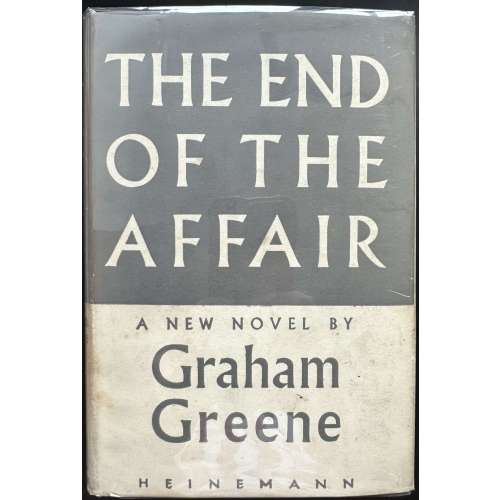 Hardcover volume, 19 x 13 cm, grey cloth with gilt lettering to spine, grey/cream dust jacket lettered throughout, price “10s 6d | NET” unclipped. Covers rubbed, dust jacket has a purple ink stain on the back bottom. Black ink inscription to recto ffl. Collation: a-o8 p10, total 122 leaves; pp.: [6] 1-237 [238]. 1st edition, 1st issue / Great Britain. Title-page: THE END OF THE | AFFAIR | by | GRAHAM GREENE | {publisher’s device} | — | WILLIAM HEINEMANN LTD | MELBOURNE :: LONDON :: TORONTO || Imprint: FIRST PUBLISHED 1951 | PRINTED IN GREAT BRITAIN | AT THE WINDMILL PRESS | KINGSWOOD, SURREY || Dedication: To C. (Catherine Walston, nee Crompton, American, 1925 – 1978) Contributors: Graham Greene (British, 1904 – 1991) William Henry Heinemann (Jewish-British, 1863 – 1920)
Hardcover volume, 19 x 13 cm, grey cloth with gilt lettering to spine, grey/cream dust jacket lettered throughout, price “10s 6d | NET” unclipped. Covers rubbed, dust jacket has a purple ink stain on the back bottom. Black ink inscription to recto ffl. Collation: a-o8 p10, total 122 leaves; pp.: [6] 1-237 [238]. 1st edition, 1st issue / Great Britain. Title-page: THE END OF THE | AFFAIR | by | GRAHAM GREENE | {publisher’s device} | — | WILLIAM HEINEMANN LTD | MELBOURNE :: LONDON :: TORONTO || Imprint: FIRST PUBLISHED 1951 | PRINTED IN GREAT BRITAIN | AT THE WINDMILL PRESS | KINGSWOOD, SURREY || Dedication: To C. (Catherine Walston, nee Crompton, American, 1925 – 1978) Contributors: Graham Greene (British, 1904 – 1991) William Henry Heinemann (Jewish-British, 1863 – 1920) -
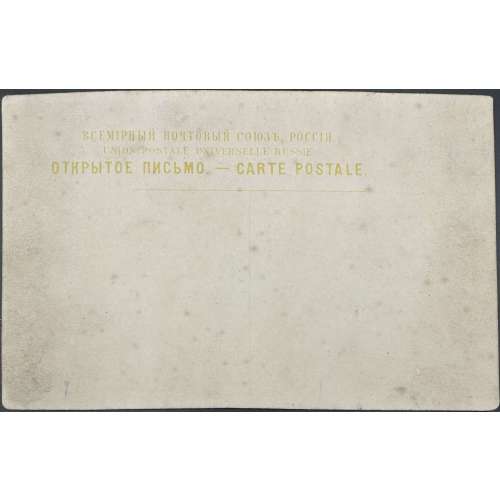 Ten postcards 90 x 140 mm, text in yellow "ВСЕМIРНЫЙ ПОЧТОВЫЙ СОЮЗЪ. РОССIЯ. | UNION POSTALE UNIVERSELLE RUSSIE. | ОТКРЫТОЕ ПИСЬМО. — CARTE POSTALE. || On the reverse, a blue ink woodcut image is printed in the upper left corner, and a blue ink numbered image title is in the bottom centre. Holding the postcard against the backlight reveals a hidden image of an indecent nature (erotic). The use of Latin characters "R" and "N" instead of Russian "Р" and "Н" suggests that the cards were produced in Europe, probably in France. Inscriptions: 1. ПЕRВЫЕ ДNИ; 2. ПОRА ЛЮБВИ; 3. ВЪ ЛЮДИ; 4. КЪ "СВОБОДNОМУ ИСКУССТВУ"; 5. "СВОБОДNЫЙ ТRУДЪ; 6. БЕЗЪ ГОRЯ И ПЕЧАЛИ; 7. NАЗАДЪ КЪ "СВОБОДNОЙ ЛЮБВИ"; 8. ВСЕ ЧТО ОСТАЛОСЬ!; 9. БЕЗЪ КRОВА И ПRИСТАNИЩА; 10. ИЗЪ ЗА ХЛѢБА.
Ten postcards 90 x 140 mm, text in yellow "ВСЕМIРНЫЙ ПОЧТОВЫЙ СОЮЗЪ. РОССIЯ. | UNION POSTALE UNIVERSELLE RUSSIE. | ОТКРЫТОЕ ПИСЬМО. — CARTE POSTALE. || On the reverse, a blue ink woodcut image is printed in the upper left corner, and a blue ink numbered image title is in the bottom centre. Holding the postcard against the backlight reveals a hidden image of an indecent nature (erotic). The use of Latin characters "R" and "N" instead of Russian "Р" and "Н" suggests that the cards were produced in Europe, probably in France. Inscriptions: 1. ПЕRВЫЕ ДNИ; 2. ПОRА ЛЮБВИ; 3. ВЪ ЛЮДИ; 4. КЪ "СВОБОДNОМУ ИСКУССТВУ"; 5. "СВОБОДNЫЙ ТRУДЪ; 6. БЕЗЪ ГОRЯ И ПЕЧАЛИ; 7. NАЗАДЪ КЪ "СВОБОДNОЙ ЛЮБВИ"; 8. ВСЕ ЧТО ОСТАЛОСЬ!; 9. БЕЗЪ КRОВА И ПRИСТАNИЩА; 10. ИЗЪ ЗА ХЛѢБА. -
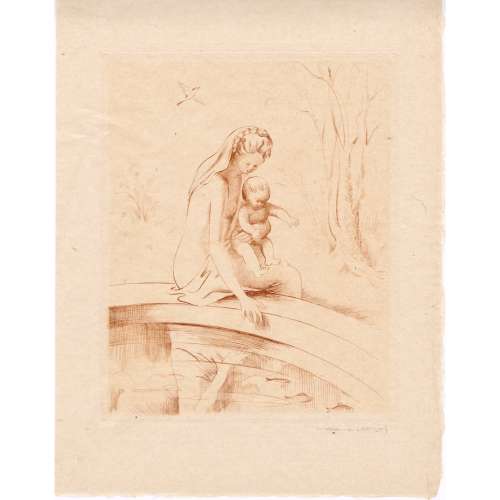 Set of 10 etchings (9 in passe-partout) printed in sanguine on the mother of pearl paper (japon nacre) from the album of 12 prints titled “Jeunesse”, presented by Gérard D'Houville (pen name of Marie de Régnier, née de Heredia) and published by La Tradition in 1945. It was a limited edition of 532 copies, some coloured on Arches paper and some as these set. Plates signed by the artist in pencil below the plate mark. The album cover is missing. Title-page: JEUNESSE | 12 EAUX-FORTES ORIGINALES | DE | MARIANNE CLOUZOT | PRÉSENTÉES | PAR | GÉRARD D'HOUVILLE | {publisher’s device} | LA TRADITION | 1945 || Dimensions: mat 330 x 255 mm; window 225 x 180 mm; sheet 280 x 220 mm; plate 220 x 170 mm. Contributors: Marianne Clouzot (French, 1908 – 2007) – artist Marie de Régnier [Marie de Heredia, Gérard d'Houville] (French, 1875 – 1963) – editor
Set of 10 etchings (9 in passe-partout) printed in sanguine on the mother of pearl paper (japon nacre) from the album of 12 prints titled “Jeunesse”, presented by Gérard D'Houville (pen name of Marie de Régnier, née de Heredia) and published by La Tradition in 1945. It was a limited edition of 532 copies, some coloured on Arches paper and some as these set. Plates signed by the artist in pencil below the plate mark. The album cover is missing. Title-page: JEUNESSE | 12 EAUX-FORTES ORIGINALES | DE | MARIANNE CLOUZOT | PRÉSENTÉES | PAR | GÉRARD D'HOUVILLE | {publisher’s device} | LA TRADITION | 1945 || Dimensions: mat 330 x 255 mm; window 225 x 180 mm; sheet 280 x 220 mm; plate 220 x 170 mm. Contributors: Marianne Clouzot (French, 1908 – 2007) – artist Marie de Régnier [Marie de Heredia, Gérard d'Houville] (French, 1875 – 1963) – editor -
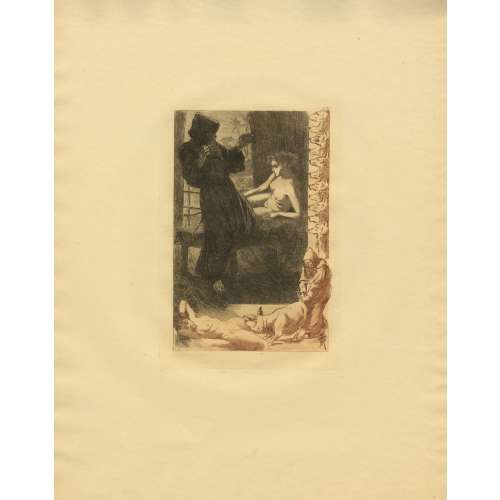 Set of 21 etchings by Martin van Maele for the English edition of ‘Thais’ by Anatole France published in London by Charles Carrington in 1901. Printed on vowe paper without a watermark in two colours with the black image and sepia historiated border. All etchings are inscribed with the artist's monogram; one of the etchings bears inscriptions ORGUEIL, LUXURE, DOUTE (mirror image). Dimensions: sheet: 317 x 250 mm; plate: 170 x 115 mm; image: 155 x 100 mm. Catalogue raisonné: S. A. Perry: № 64. Per Perry, the edition was printed in 500 copies on 'handmade paper watermarked 'Van Gelder'. Contributor: Martin van Maële [Martin, Maurice François Alfred] (French, 1863 – 1926)
Set of 21 etchings by Martin van Maele for the English edition of ‘Thais’ by Anatole France published in London by Charles Carrington in 1901. Printed on vowe paper without a watermark in two colours with the black image and sepia historiated border. All etchings are inscribed with the artist's monogram; one of the etchings bears inscriptions ORGUEIL, LUXURE, DOUTE (mirror image). Dimensions: sheet: 317 x 250 mm; plate: 170 x 115 mm; image: 155 x 100 mm. Catalogue raisonné: S. A. Perry: № 64. Per Perry, the edition was printed in 500 copies on 'handmade paper watermarked 'Van Gelder'. Contributor: Martin van Maële [Martin, Maurice François Alfred] (French, 1863 – 1926) -
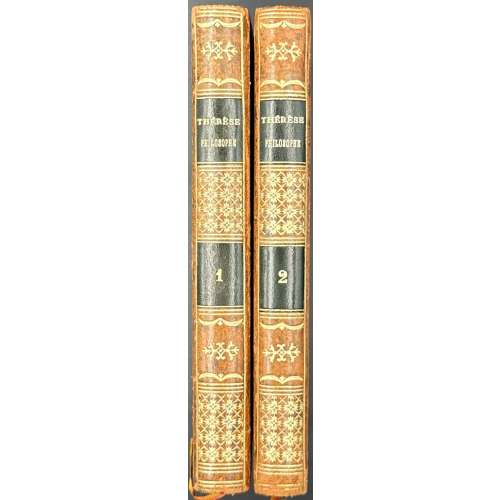 Two volumes, 168 x 106 mm each, uniformly bound in faux mottled calf ruled in gilt, marbled endpapers. Vol. 1: 3 blank leaves of wove paper, 3 blank leaves of laid paper, half-title/blank, blank/frontispiece, ‘engraved’ t.p./blank, both printed on laid paper watermarked “ARCHES A LA | MAIN”; ‘letterpress’ t.p.,/blank, pp.: [1] 2-115 [116 blank], 3 blank leaves of laid paper, 3 blank leaves of wove paper; collated 12mo: π2 A-I6 K4; total 60 leaves plus 16 ‘engraved’ plates, incl. t.p. and frontis. Vol. 2: 3 blank leaves of wove paper, 3 blank leaves of laid paper, half-title/blank, blank/frontispiece, ‘engraved’ t.p./blank, no watermark, ‘letterpress’ t.p.,/blank, pp.: 1-77 [78 blank], 2 blank leaves of laid paper, 3 blank leaves of wove paper; collated 12mo: π2 A-F6 G3; total 41 leaves plus 24 ‘engraved’ plates, incl. t.p. and frontis. Dutel (I): A-1089, p. 325: in-8 (probably by size only, no formula suggested), pagination 115 and 77 as here, 2 frontispieces, 2 engraved titles dated 1873, “et 36 belles gravures de Binet”. Cohen-DeRicci: p. 734 bottom: in-12, no pagination, no formula. "Thérèse" was offered by a French seller user-75d14f4 on the online auction platform CATAWIKI in December 2021. The seller's description of this two-volume set was: "Re-edition, the date of which I was unable to determine. (London, no name, 1782) 2 duodecimo volumes of 115 and 77 pp., very lovely marbled sheepskin pastiche bindings, gilded triple fillets, adorned spines, black title labels. This classic of 18th-century clandestine erotica was written in 1748 by an author who has remained anonymous, attributed at the time to Montigny, which led to his internment in the Bastille. It is now attributed to the Jean-Baptiste de Boyer, Marquis d'Argens. Edition illustrated with 37 very unrestrained figures, engraved in intaglio after Borel, unsigned." I should have paid more attention to the first phase, about the re-edition, but I didn't. After a few bidding rounds, I won the book when the hammer price was 2,200 Euros. On the 28th of December, 2021, I paid for this little beauty $2,760. The book arrived a few days later. The paper's quality and texture, the watermark, the absence of the platemark, and the lack of embossing on the back (text and plates) made me suspect it was a fake. The pages were absolutely flat to the touch! I established clear evidence of a high-resolution 'xerox' copy using Celestron Micro Capture Pro micro-photography. I wrote to the seller and the auction platform, explaining my doubts regarding its authenticity. To prove my point, I include a few micro photos of the "Thérèse" and some books printed at the end of the 18th century. I explained why I considered it a fake and requested a return/refund. After two months of email exchanges, the seller and the platform refused to pay me back. Today is the 2nd anniversary of the purchase. I still have the book. To celebrate my carelessness, I included it in my library to warn fellow book collectors about buying from an unknown dealer via certain online auction platforms. Ref.: Bamber Gascoigne. How to Identify Prints: A Complete Guide to Manual and Mechanical Processes from Woodcut to Ink. — Thames and Hudson, 1995.
Two volumes, 168 x 106 mm each, uniformly bound in faux mottled calf ruled in gilt, marbled endpapers. Vol. 1: 3 blank leaves of wove paper, 3 blank leaves of laid paper, half-title/blank, blank/frontispiece, ‘engraved’ t.p./blank, both printed on laid paper watermarked “ARCHES A LA | MAIN”; ‘letterpress’ t.p.,/blank, pp.: [1] 2-115 [116 blank], 3 blank leaves of laid paper, 3 blank leaves of wove paper; collated 12mo: π2 A-I6 K4; total 60 leaves plus 16 ‘engraved’ plates, incl. t.p. and frontis. Vol. 2: 3 blank leaves of wove paper, 3 blank leaves of laid paper, half-title/blank, blank/frontispiece, ‘engraved’ t.p./blank, no watermark, ‘letterpress’ t.p.,/blank, pp.: 1-77 [78 blank], 2 blank leaves of laid paper, 3 blank leaves of wove paper; collated 12mo: π2 A-F6 G3; total 41 leaves plus 24 ‘engraved’ plates, incl. t.p. and frontis. Dutel (I): A-1089, p. 325: in-8 (probably by size only, no formula suggested), pagination 115 and 77 as here, 2 frontispieces, 2 engraved titles dated 1873, “et 36 belles gravures de Binet”. Cohen-DeRicci: p. 734 bottom: in-12, no pagination, no formula. "Thérèse" was offered by a French seller user-75d14f4 on the online auction platform CATAWIKI in December 2021. The seller's description of this two-volume set was: "Re-edition, the date of which I was unable to determine. (London, no name, 1782) 2 duodecimo volumes of 115 and 77 pp., very lovely marbled sheepskin pastiche bindings, gilded triple fillets, adorned spines, black title labels. This classic of 18th-century clandestine erotica was written in 1748 by an author who has remained anonymous, attributed at the time to Montigny, which led to his internment in the Bastille. It is now attributed to the Jean-Baptiste de Boyer, Marquis d'Argens. Edition illustrated with 37 very unrestrained figures, engraved in intaglio after Borel, unsigned." I should have paid more attention to the first phase, about the re-edition, but I didn't. After a few bidding rounds, I won the book when the hammer price was 2,200 Euros. On the 28th of December, 2021, I paid for this little beauty $2,760. The book arrived a few days later. The paper's quality and texture, the watermark, the absence of the platemark, and the lack of embossing on the back (text and plates) made me suspect it was a fake. The pages were absolutely flat to the touch! I established clear evidence of a high-resolution 'xerox' copy using Celestron Micro Capture Pro micro-photography. I wrote to the seller and the auction platform, explaining my doubts regarding its authenticity. To prove my point, I include a few micro photos of the "Thérèse" and some books printed at the end of the 18th century. I explained why I considered it a fake and requested a return/refund. After two months of email exchanges, the seller and the platform refused to pay me back. Today is the 2nd anniversary of the purchase. I still have the book. To celebrate my carelessness, I included it in my library to warn fellow book collectors about buying from an unknown dealer via certain online auction platforms. Ref.: Bamber Gascoigne. How to Identify Prints: A Complete Guide to Manual and Mechanical Processes from Woodcut to Ink. — Thames and Hudson, 1995.
Books used for comparison: [LIB-2743.2021] Restif de la Bretonne. Les parisiennes, ou XL caractères généraux pris dans les mœurs actuelles, propres à servir à l’instruction des personnes-du-sexe / 4 vol. — Neufchâtel, et Paris: Guillot, 1787. [LIB-3027.2022] [Héliodore d’Emèse]. Amours de Théagènes et Chariclée: Histoire Éthiopique / 2 vol. — Londres [i.e. Paris]: [s.n.], 1743. [LIB-3252.2023] [Nicolas Chorier.] Le Meursius françois, ou entretiens galans d’Aloysia, orné de figures. — Cythere [i.e. Paris: Cazin], 1782. Below is a Xerox copy for comparison.Thérèse philosophe, 1783.
Late 18th century books
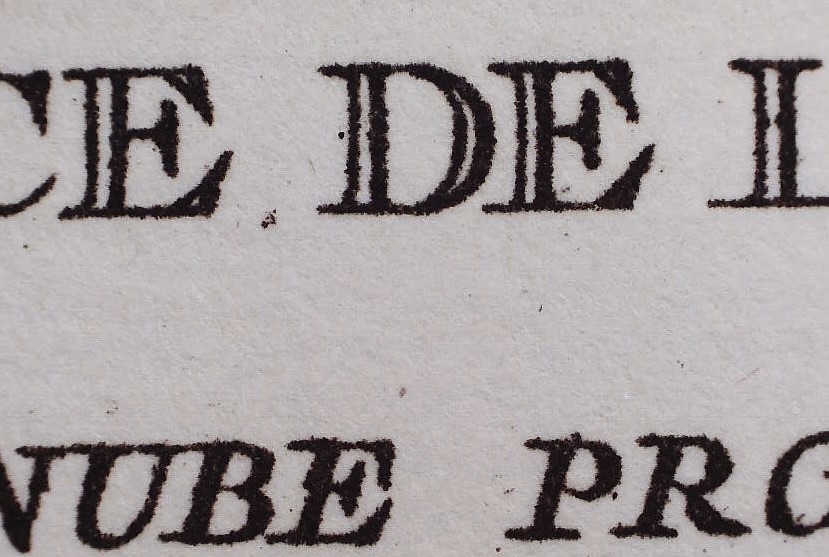

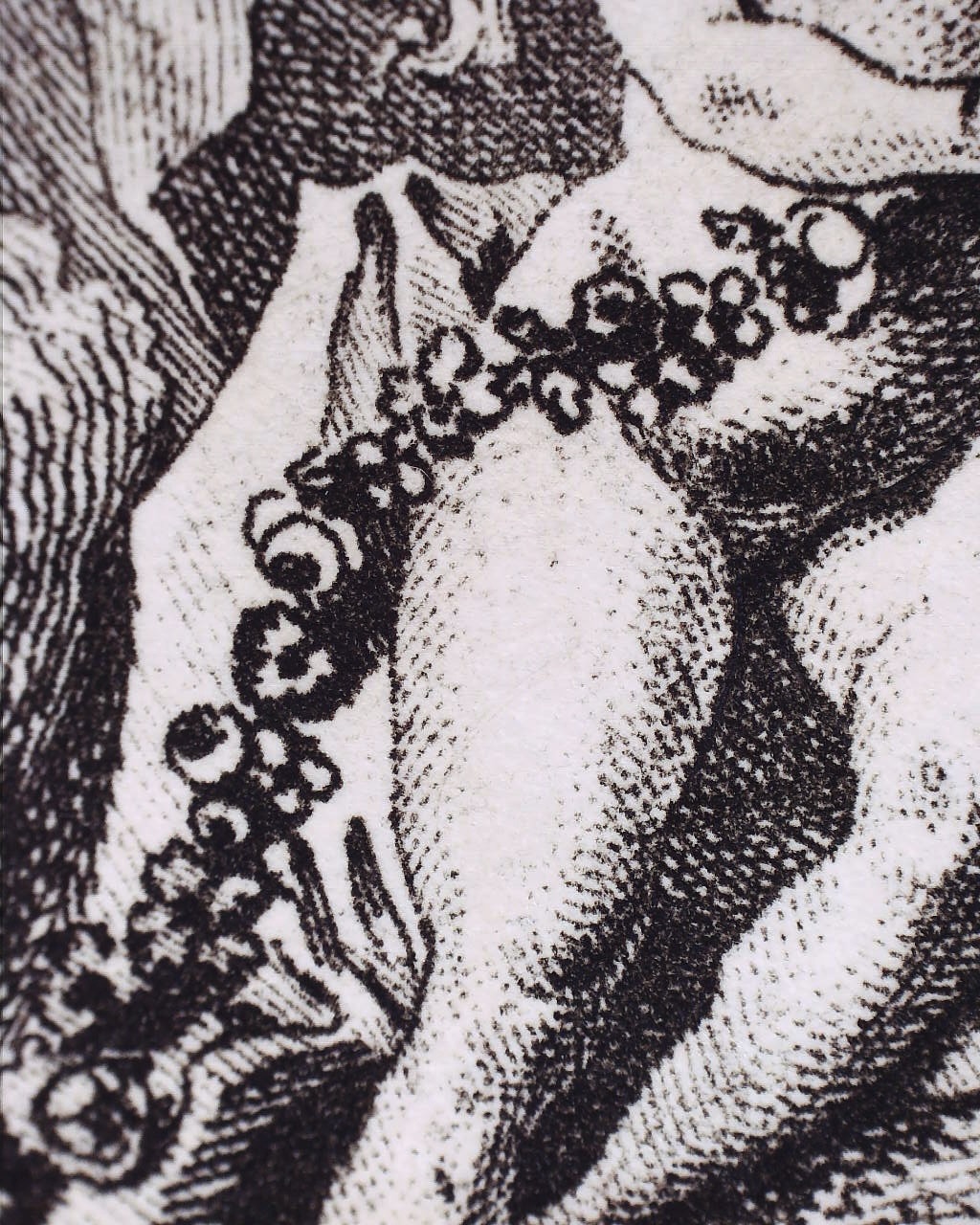
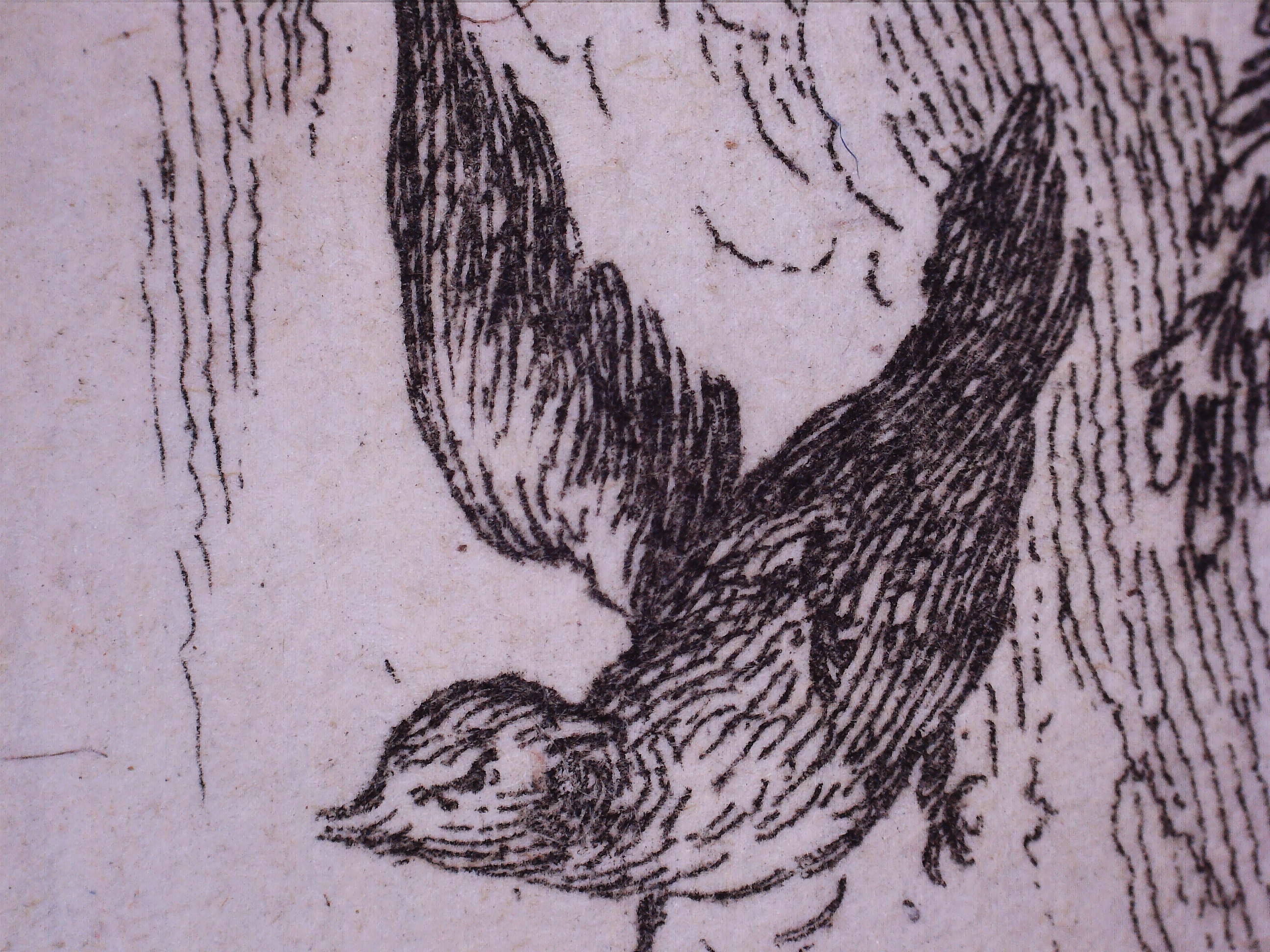
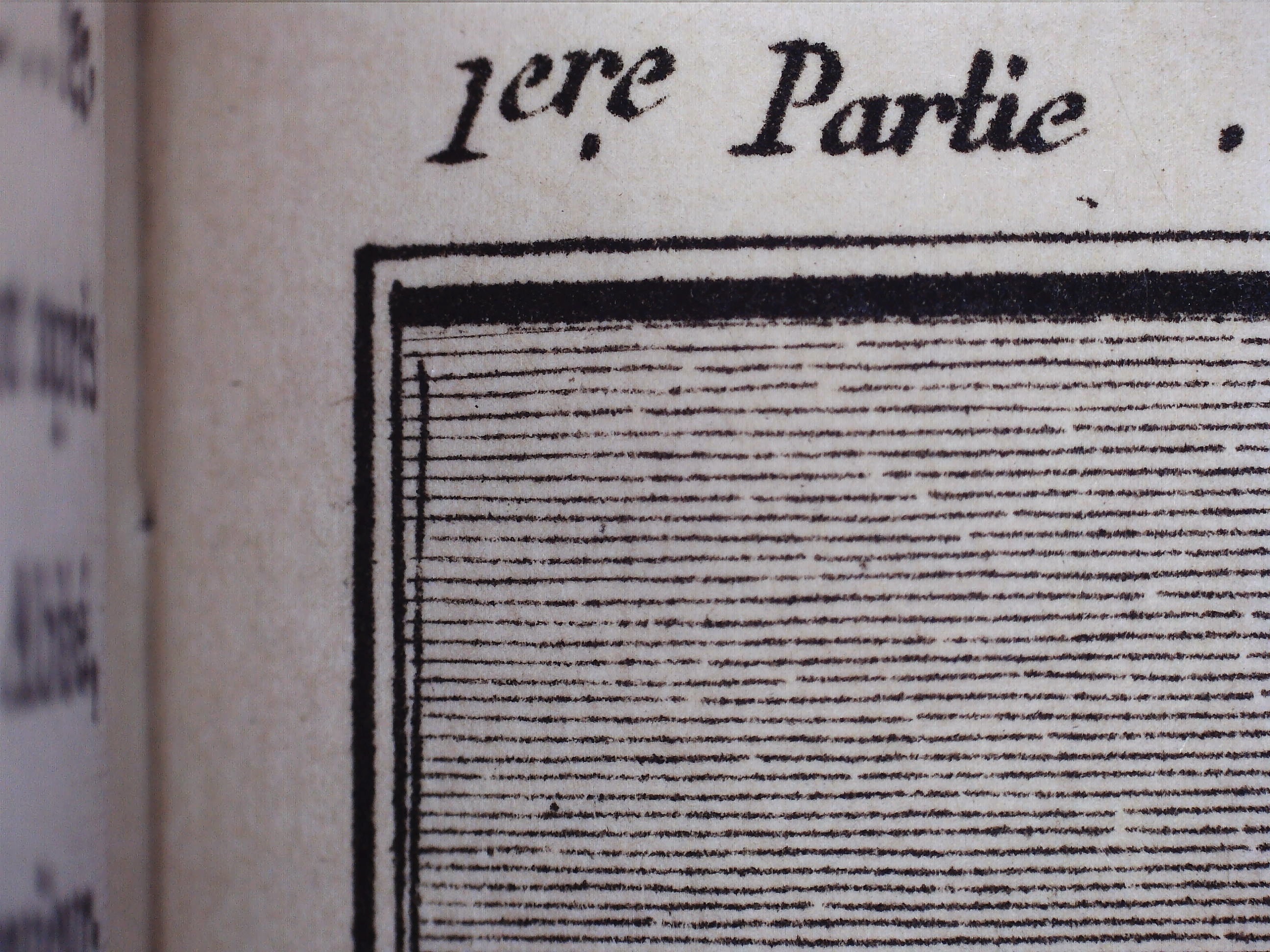
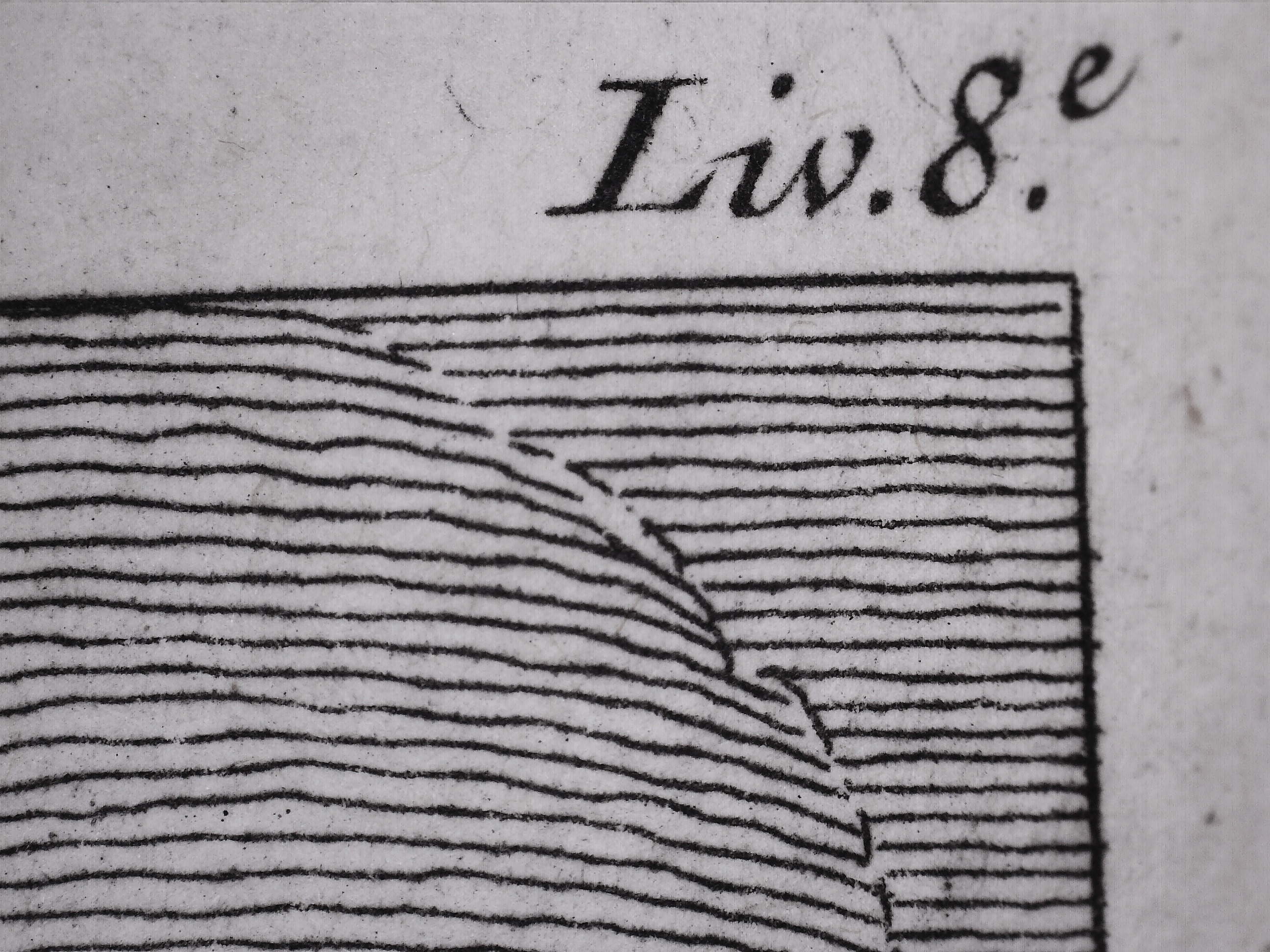
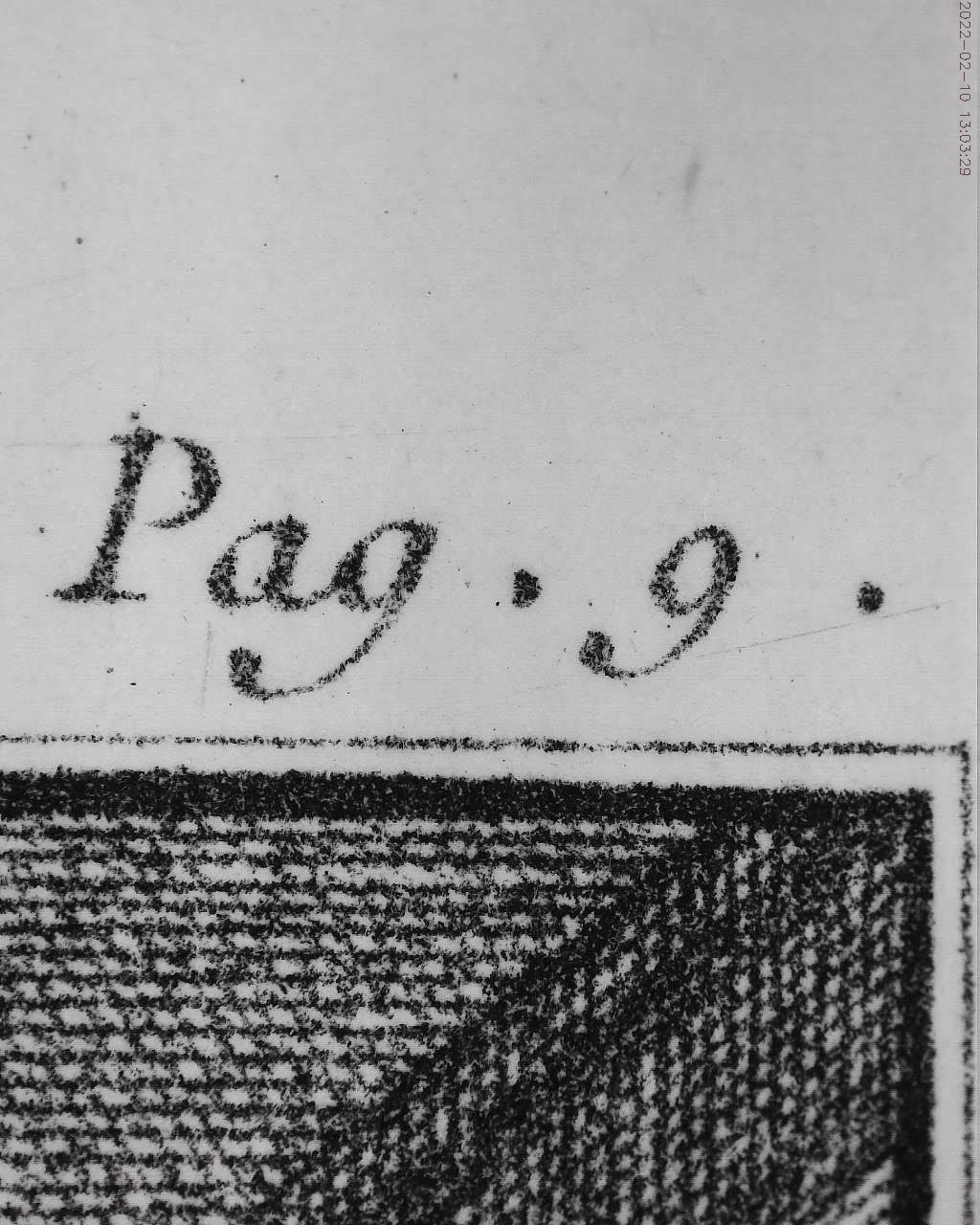
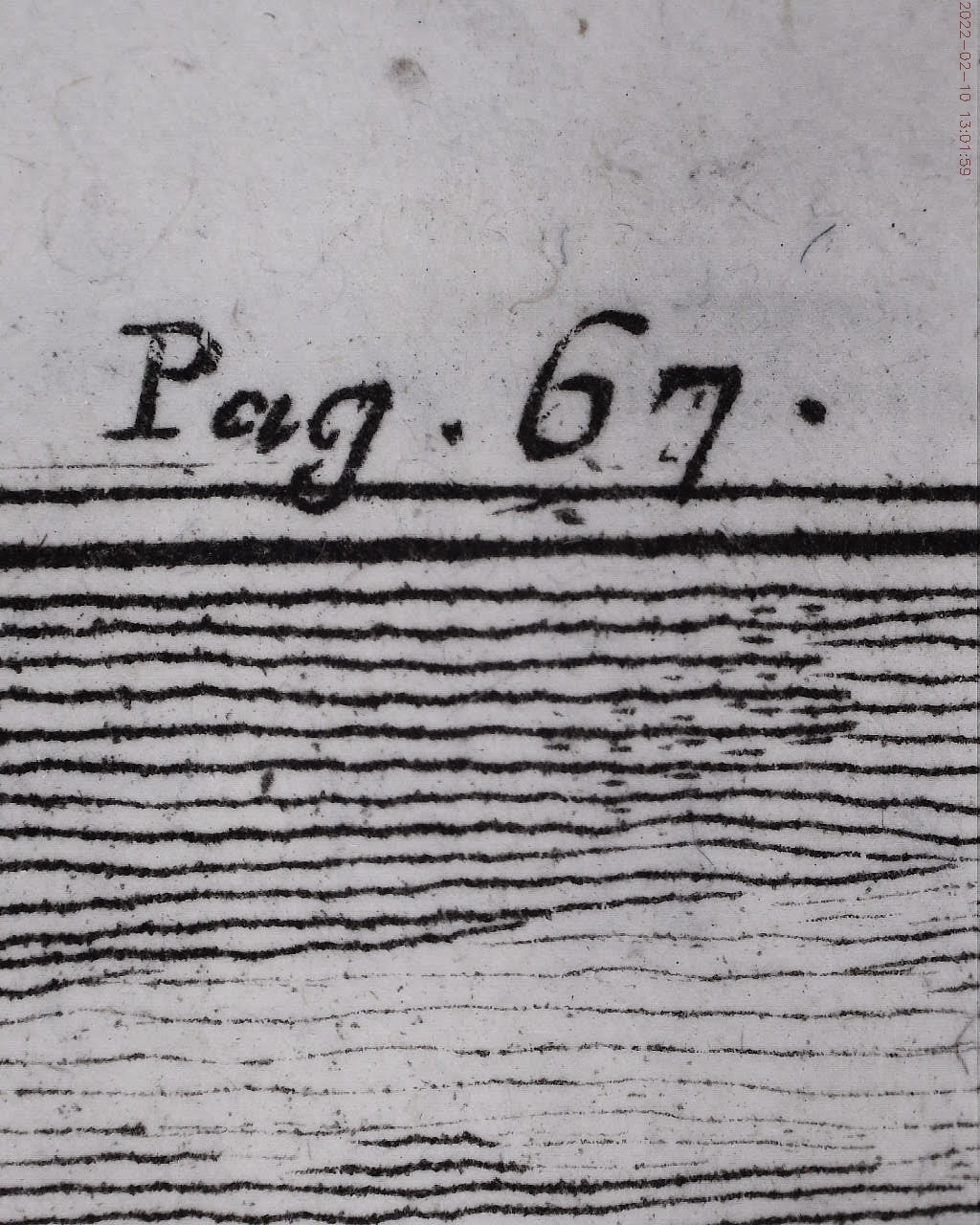

-
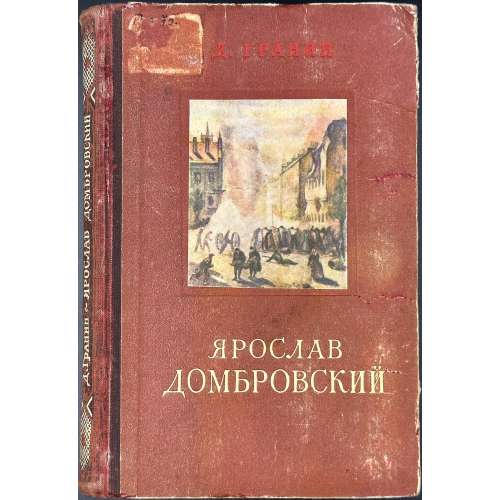 Hardcover, 20.4 x 14 cm, quarter burgundy cloth over paper boards with red and beige lettering and vignette to front and beige lettering to spine; pp.: [1-4] 5-182 [2], collation 8vo: 1-118 124, total 92 leaves. Design of binding and t.p. by В. Телепнев. Library pocket, stamps, and inscriptions. Title-page (red and black): Д. ГРАНИН | ЯРОСЛАВ | ДОМБРОВСКИЙ | ~ | ✸ | Издательство ЦК ВЛКСМ | “Молодая гвардия” | 1951 || Print run: 15,000 copies. Contributors: Даниил Александрович Гранин (Russian, 1919 – 2017) – author. Владимир Иванович Телепнев (Russian, 1906 – 1985) – artist. Jaroslaw Dombrowski [Jarosław Dąbrowski] (Polish-French, 1836 – 1871) – character.
Hardcover, 20.4 x 14 cm, quarter burgundy cloth over paper boards with red and beige lettering and vignette to front and beige lettering to spine; pp.: [1-4] 5-182 [2], collation 8vo: 1-118 124, total 92 leaves. Design of binding and t.p. by В. Телепнев. Library pocket, stamps, and inscriptions. Title-page (red and black): Д. ГРАНИН | ЯРОСЛАВ | ДОМБРОВСКИЙ | ~ | ✸ | Издательство ЦК ВЛКСМ | “Молодая гвардия” | 1951 || Print run: 15,000 copies. Contributors: Даниил Александрович Гранин (Russian, 1919 – 2017) – author. Владимир Иванович Телепнев (Russian, 1906 – 1985) – artist. Jaroslaw Dombrowski [Jarosław Dąbrowski] (Polish-French, 1836 – 1871) – character. -
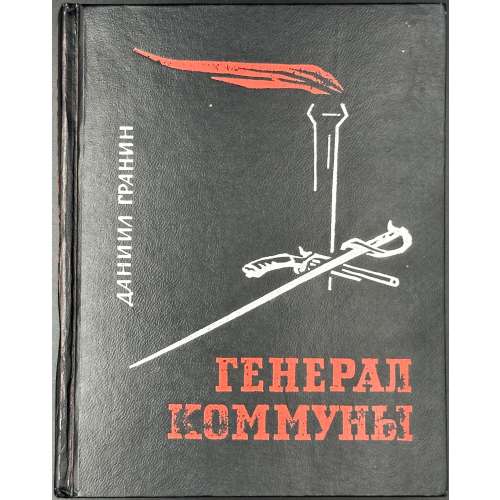 Hardcover, 17 x 13.4 cm, black buckram with red and silver vignette, lettering to front and spine, price and publisher's name embossed to back, pictorial endpapers with white lettering to red strips; pp.: [1-4] 5-268 [4], ils., collation: 16mo: 116 28 3-616 7-88 9-1016, total 136 leaves plus 3 photo plates after p. 32, 48, and 208. Frontispiece and in-text woodcuts after И. И. Старосельский. Title-page (red and black): ДАНИИЛ ГРАНИН | ГЕНЕРАЛ КОММУНЫ | (ЯРОСЛАВ ДОМБРОВСКИЙ) | — | Издательство | «СОВЕТСКАЯ РОССИЯ» | Москва — 1965 || Print run: 50,000 copies. Contributors: Даниил Александрович Гранин (Russian, 1919 – 2017) – author. Илья Израилевич Старосельский (Russian-Jewish, 1918 – 1968) – artist. Jaroslaw Dombrowski [Jarosław Dąbrowski] (Polish-French, 1836 – 1871) – character.
Hardcover, 17 x 13.4 cm, black buckram with red and silver vignette, lettering to front and spine, price and publisher's name embossed to back, pictorial endpapers with white lettering to red strips; pp.: [1-4] 5-268 [4], ils., collation: 16mo: 116 28 3-616 7-88 9-1016, total 136 leaves plus 3 photo plates after p. 32, 48, and 208. Frontispiece and in-text woodcuts after И. И. Старосельский. Title-page (red and black): ДАНИИЛ ГРАНИН | ГЕНЕРАЛ КОММУНЫ | (ЯРОСЛАВ ДОМБРОВСКИЙ) | — | Издательство | «СОВЕТСКАЯ РОССИЯ» | Москва — 1965 || Print run: 50,000 copies. Contributors: Даниил Александрович Гранин (Russian, 1919 – 2017) – author. Илья Израилевич Старосельский (Russian-Jewish, 1918 – 1968) – artist. Jaroslaw Dombrowski [Jarosław Dąbrowski] (Polish-French, 1836 – 1871) – character. -
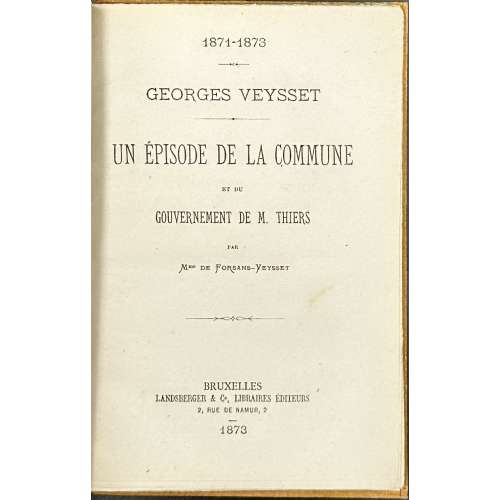 Owner’s hardcover, 182 x 120 mm, yellow buckram, crimson morocco label to spine with gilt lettering; publisher’s pink wrappers preserved, round engraved bookplate to front pastedown “DE LA BIBLIOTHÈQUE DE JULES RICHARD” cut to the border (“Imp. r. C. Motteroz” cut out); Pp.: [4] [1-5] 6-83 [84], various mss and printed clippings, 2 extra ffls to front and back. Title-page: 1871-1873 | — | GORGES VEYSSET | — | UN ÉPISODE DE LA COMMUNE | ET DU | GOUVERNEMENT DE M. THIERS | PAR | Mme DE FORSANS-YEYSSET | — | BRUXELLES | LANDSBERGER & C°, LIBRAIRES ÉDITEURS | 2, RUE DE NAMUR, 2 | 1873 || Provenance: Jules Richard (French, 1848 – 1930). Ref: BNF.
Owner’s hardcover, 182 x 120 mm, yellow buckram, crimson morocco label to spine with gilt lettering; publisher’s pink wrappers preserved, round engraved bookplate to front pastedown “DE LA BIBLIOTHÈQUE DE JULES RICHARD” cut to the border (“Imp. r. C. Motteroz” cut out); Pp.: [4] [1-5] 6-83 [84], various mss and printed clippings, 2 extra ffls to front and back. Title-page: 1871-1873 | — | GORGES VEYSSET | — | UN ÉPISODE DE LA COMMUNE | ET DU | GOUVERNEMENT DE M. THIERS | PAR | Mme DE FORSANS-YEYSSET | — | BRUXELLES | LANDSBERGER & C°, LIBRAIRES ÉDITEURS | 2, RUE DE NAMUR, 2 | 1873 || Provenance: Jules Richard (French, 1848 – 1930). Ref: BNF. -
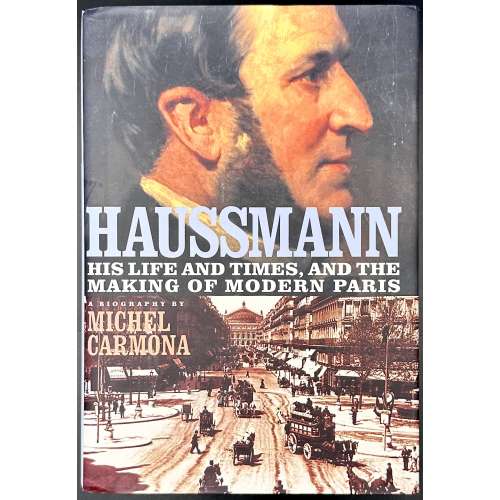 Hardcover, 242 x 168 mm, quarter burgundy cloth over blue paper boards, outer edge untrimmed; pp.: [6] [1-4] 5-516 [2 colophon/blank] [6 blanks]. First published in France in 2000 as “Haussmann” by Librairie Arthème Fayard. Title-page: HAUSSMANN | ~ | His Life and Times, | and the Making of Modern Paris | MICHEL CARMONA | TRANSLATED FROM THE FRENCH BY PATRICK CAMILER | {publisher’s device} | Ivan • R • Dee | Chicago 2002 || Michel Carmona (French, b. 1940) Georges-Eugène Haussmann [Baron Haussmann] (French, 1809 – 1891)
Hardcover, 242 x 168 mm, quarter burgundy cloth over blue paper boards, outer edge untrimmed; pp.: [6] [1-4] 5-516 [2 colophon/blank] [6 blanks]. First published in France in 2000 as “Haussmann” by Librairie Arthème Fayard. Title-page: HAUSSMANN | ~ | His Life and Times, | and the Making of Modern Paris | MICHEL CARMONA | TRANSLATED FROM THE FRENCH BY PATRICK CAMILER | {publisher’s device} | Ivan • R • Dee | Chicago 2002 || Michel Carmona (French, b. 1940) Georges-Eugène Haussmann [Baron Haussmann] (French, 1809 – 1891) -
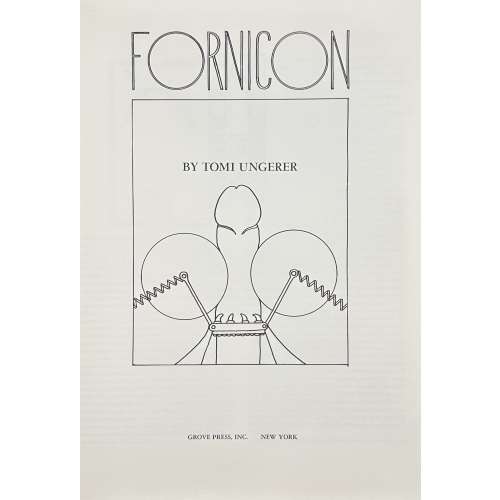 Hardcover, 333 x 247 mm, black cloth with gilt facsimile to front board and gilt lettering to spine, aubergine dust jacket with white lettering and red facsimile over black panel to front and back, crimson endpapers, laid paper, unpaginated; pp.: [4] h.t./blank, t.p./imprint, [2] text by John Hollander, 61 leaves of plates; originally published in 1969 by Rhinoceros Press, New York, as a limited-edition portfolio with slipcase. Title-page: Fornicon | (in frame) BY TOMI UNGERER | GROVE PRESS NEW YORK || Jean-Thomas [Tomi] Ungerer (French,1931 – 2019) John Hollander (American, 1929 – 2013)
Hardcover, 333 x 247 mm, black cloth with gilt facsimile to front board and gilt lettering to spine, aubergine dust jacket with white lettering and red facsimile over black panel to front and back, crimson endpapers, laid paper, unpaginated; pp.: [4] h.t./blank, t.p./imprint, [2] text by John Hollander, 61 leaves of plates; originally published in 1969 by Rhinoceros Press, New York, as a limited-edition portfolio with slipcase. Title-page: Fornicon | (in frame) BY TOMI UNGERER | GROVE PRESS NEW YORK || Jean-Thomas [Tomi] Ungerer (French,1931 – 2019) John Hollander (American, 1929 – 2013) -
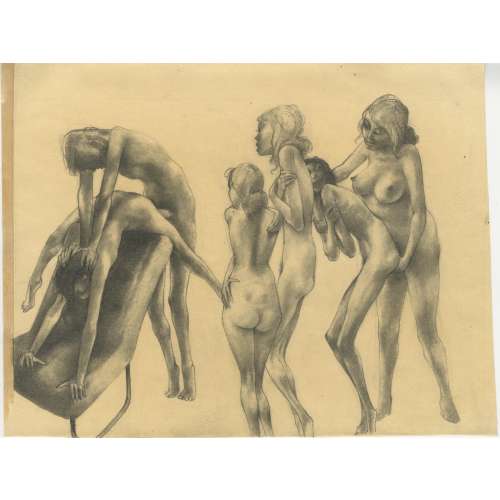 Graphite on wove paper, 217 x 284 mm, black ink stamp to verso: “Prof O. R. Schatz | Wien II, Gr. Mohreng 3b | Tel.: 55 82 566”. Unsigned, attributed to Otto Rudolf Schatz (Austrian, 1900 – 1961).
Graphite on wove paper, 217 x 284 mm, black ink stamp to verso: “Prof O. R. Schatz | Wien II, Gr. Mohreng 3b | Tel.: 55 82 566”. Unsigned, attributed to Otto Rudolf Schatz (Austrian, 1900 – 1961). -
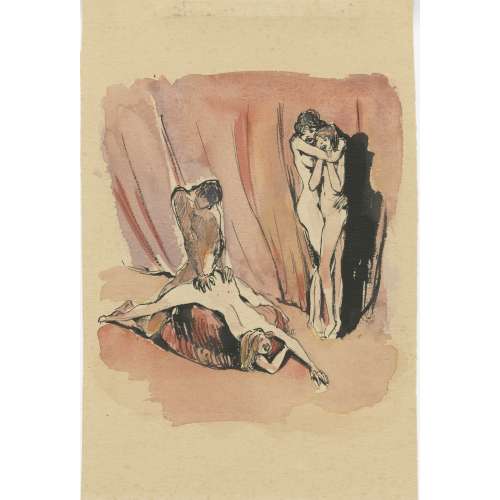 Watercolour on wove paper, 243 x 161 mm, black ink stamp to verso: “Nachlaß O R SCHATS”. Attributed to Otto Rudolf Schatz (Austrian, 1900 – 1961).
Watercolour on wove paper, 243 x 161 mm, black ink stamp to verso: “Nachlaß O R SCHATS”. Attributed to Otto Rudolf Schatz (Austrian, 1900 – 1961). -
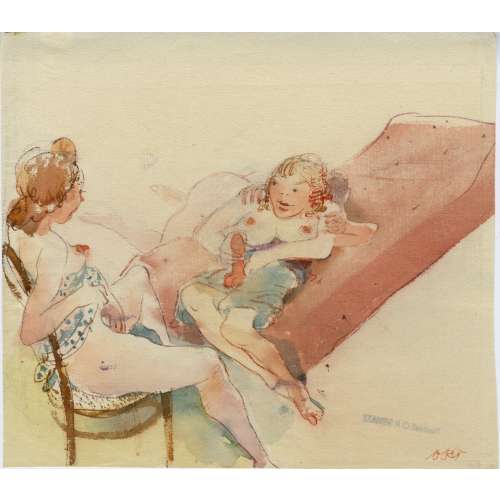 Watercolour on laid paper, 198 x 225 mm, signed or stamped in orange ink “ORS” to recto [Otto Rudolf Schatz (Austrian, 1900 – 1961)]; black ink stamp: “Nachlaß O R SCHATS”, pencil “ss” in the bottom left corner, and remnants of a hinge on the upper right to verso.
Watercolour on laid paper, 198 x 225 mm, signed or stamped in orange ink “ORS” to recto [Otto Rudolf Schatz (Austrian, 1900 – 1961)]; black ink stamp: “Nachlaß O R SCHATS”, pencil “ss” in the bottom left corner, and remnants of a hinge on the upper right to verso. -
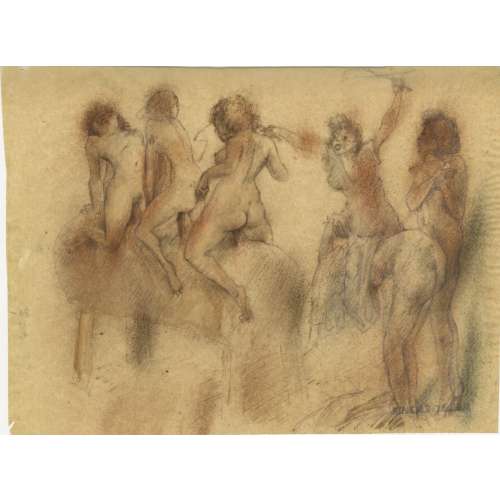 Pencil, pen and ink wash on india paper, 170 x 228 mm, black ink stamp to verso: “Nachlaß O R SCHATS”. Unsigned, attributed to Otto Rudolf Schatz (Austrian, 1900 – 1961).
Pencil, pen and ink wash on india paper, 170 x 228 mm, black ink stamp to verso: “Nachlaß O R SCHATS”. Unsigned, attributed to Otto Rudolf Schatz (Austrian, 1900 – 1961). -
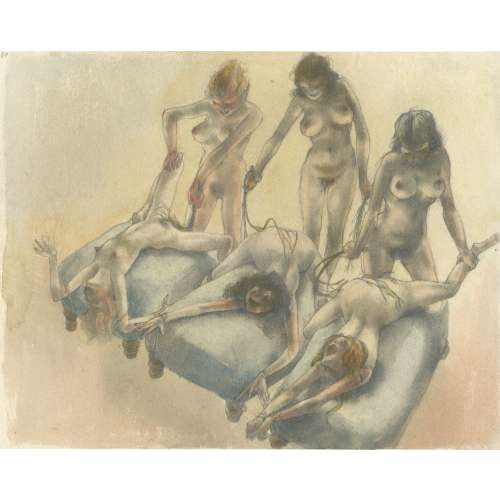 Watercolour on laid paper watermarked “HOLLAND”, 255 x 324 mm, number “10” ms pencil in the upper left corner, remnants of hinges to verso; unsigned. Attributed to Otto Rudolf Schatz (Austrian, 1900 – 1961).
Watercolour on laid paper watermarked “HOLLAND”, 255 x 324 mm, number “10” ms pencil in the upper left corner, remnants of hinges to verso; unsigned. Attributed to Otto Rudolf Schatz (Austrian, 1900 – 1961).


